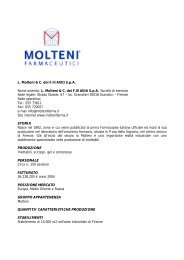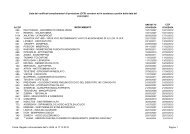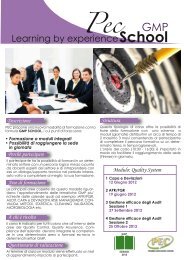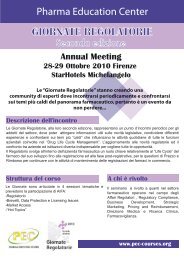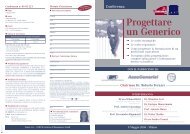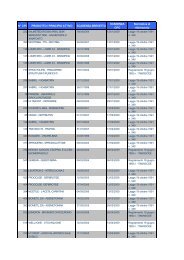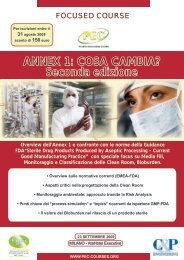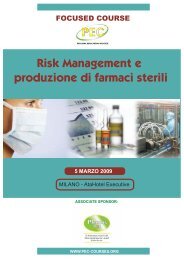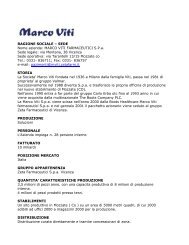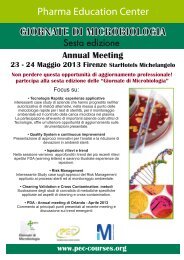Sustaining Generic Medicines Markets in Europe
Sustaining Generic Medicines Markets in Europe
Sustaining Generic Medicines Markets in Europe
You also want an ePaper? Increase the reach of your titles
YUMPU automatically turns print PDFs into web optimized ePapers that Google loves.
<strong>Susta<strong>in</strong><strong>in</strong>g</strong> generic medic<strong>in</strong>es markets 62The RPS <strong>in</strong>itially applied to a small proportion of the pharmaceutical market: 114 homogeneousgroups conta<strong>in</strong><strong>in</strong>g 590 medic<strong>in</strong>es, account<strong>in</strong>g for 10% of public pharmaceutical expenditure(Antonanzas, 2003). S<strong>in</strong>ce then, the scope of the RPS has been enlarged to cover, for example,200 groups of medic<strong>in</strong>es <strong>in</strong> 2002.In 2003, some features of the RPS were changed. The breadth of homogeneous groups wasenlarged to <strong>in</strong>clude all presentations and pharmaceutical forms (except for retard and paediatricforms) of the same active substance. The RP was calculated as the average of the three lowestcosts per daily def<strong>in</strong>ed dose for each pharmaceutical form of an active substance. In 2004, theaddition of new active substances to the RPS was suspended.12.2.4 Incentives for physiciansThe prescrib<strong>in</strong>g behaviour of physicians is assisted by computerised prescrib<strong>in</strong>g and a medic<strong>in</strong>edatabase. In most Spanish regions, primary care physicians can earn additional annual lumpsums if they meet targets relat<strong>in</strong>g to, for example, generic medic<strong>in</strong>es prescription rates. Theimpact of such measures is likely to be limited as these <strong>in</strong>centive payments make upapproximately 2% of the physician’s gross salary (Antonanzas, 2003). On the other hand,physicians are not obliged or stimulated to prescribe by INN.12.2.5 Incentives for pharmacistsThe implementation of the 2000 RPS was supported by the ability of pharmacists to substitutegeneric for orig<strong>in</strong>ator medic<strong>in</strong>es (unless the patient specifically demands the orig<strong>in</strong>ator medic<strong>in</strong>e).<strong>Generic</strong> substitution by pharmacists encountered physician resistance (Rovira and Albarrac<strong>in</strong>,2001), although no evidence of its effect on substitution rates has been discovered.A new system of regressive pharmacist marg<strong>in</strong>s was <strong>in</strong>troduced <strong>in</strong> 2000. For medic<strong>in</strong>es with anex-factory price at or below 78.34 €, pharmacist marg<strong>in</strong>s were set at 33% for generic medic<strong>in</strong>esas compared with 27.9% for non-generic medic<strong>in</strong>es. For medic<strong>in</strong>es priced above 78.34 €,pharmacist marg<strong>in</strong>s were fixed at 33.54 €. Currently, pharmacists receive a marg<strong>in</strong> of 27.9%,irrespective of whether it concerns an orig<strong>in</strong>ator or generic medic<strong>in</strong>e.In 2003, explicit rules govern<strong>in</strong>g generic substitution by pharmacists were specified. <strong>Generic</strong>substitution of brand-name (orig<strong>in</strong>ator or generic) medic<strong>in</strong>es depends on the price of themedic<strong>in</strong>e. If the medic<strong>in</strong>e price is <strong>in</strong>ferior or equal to the RP, the pharmacist has to dispense thebrand-name medic<strong>in</strong>e. If the medic<strong>in</strong>e price surpasses the RP and the medic<strong>in</strong>e class conta<strong>in</strong>s




